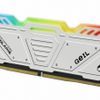Final Words & Conclusion
Final Words & Conclusion
The Geil Polaris RGB 8000 CL38 kit offers users an outstanding performance already out of the box. It looks attractive; the lighting is done well for the RGB-lovers. If you’re not into it, there is a non-RGB variant from Geil’s Polaris series. The frequency range is extensive, from 4800 to 8000 (reviewed). Additionally, you can choose from three colors, white (which we got), grey, and red, and several capacities, up to 2x32 GB kits.
Aesthetics
Geil has made GEIL Polaris RGB attractive. The RGB works as it should, and you can set lighting using the motherboard utilities. Overall, we’re satisfied with what GEIL Polaris RGB offers in that department.
Tweaking
The memory chips used here come from Hynix, A-Die. As we usually state, the overclocking capabilities' reproducibility is never guaranteed, and your results may vary. The reviewed kit –is already a fantastic result out of the box, but you need to have an Intel CPU with a good IMC (Integrated Memory Controller) and a 2 DIMM motherboard (like the Z790 Apex – big thanks for Geil for providing the motherboard). Another thing worth mentioning is that you'd better keep the memory cooler than 70 degrees Celsius, but it's even more preferred to stay below 60 degrees. We've used a 120 mm fan placed above the kit for that. It was possible to tighten the timings (8000 CL36-46-46-80 was stable), but it didn't provide a visible performance difference.
Conclusion
Geil Polaris RGB is a great memory series. The stock performance is within the expected range (8000 MHz is the absolute high-end), and the XMP 3.0 profile makes life easier (at least in theory, as you need to have a proper CPU/mainboard and preferable additional air cooling). The relatively low-profile heat spreader (43 mm/1.69 inches), so you shouldn't encounter clearance problems with more extensive air CPU coolers. Some very little headroom (tighter timings) is still available, but it wasn't worth the effort (probably a better CPU sample would allow better OC results). Also – it would help if you focused on lowering the temperatures below 70 degrees Celsius (or even below 60). The 32 GB option is a lot for most users nowadays, although it's becoming a standard even in gaming set-ups, also because of the introduction of the new RAM standard. The current price for the DDR5s is decreasing rapidly, thanks to the AM5 platform introduction. We want to give Geil a "Guru3D Top Pick" award for this kit as it's fast out of the box. The temperature is relatively low, and the aluminum heat spreaders are effective. You also get customizable RGB lighting (but that's a market standard now). You can select a red or gray (not white) variant and a non-RGB version (but this has a narrower range of possible frequencies). What would you like more? Practically nothing (except the price), but it's a general note –it's a pity that enabling the 8000 MHz XMP profile is not so straightforward (it's very restrictive regarding the CPU/mainboard and the temperatures). Probably the next generation of Intel CPUs will make it easier. Additionally, maybe also the AM5 would allow higher frequencies (with Infinity Fabric working in 1:1 mode) in the future. Besides that, it's an attractive DDR5 kit, but the price is still the main downside of this standard.
- Sign up to receive a notification when we publish a new article
- Or go back to Guru3D's front page.


